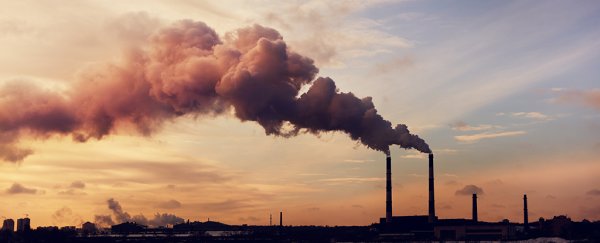Despite efforts to curb greenhouse gas emissions, the level of carbon dioxide in Earth's atmosphere hit a new high in April: an average of more than 410 parts per million (ppm). That's the highest point yet across the data we have for the last 800,000 years.
The exact figure of CO2 concentration was 410.31 ppm, as measured by the Keeling Curve dataset collected at the Mauna Loa Observatory in Hawaii.
It's another alarming wake-up call – as if we needed one – about the damage we're doing to our planet, and how drastic action is required to avoid some pretty catastrophic environmental consequences in the decades to come.
"We keep burning fossil fuels," says geochemist Ralph Keeling, the son of Keeling Curve creator Charles David Keeling, and the director of the Scripps CO2 Program that carries out these regular measurements.
"Carbon dioxide keeps building up in the air. It's essentially as simple as that."
It's not as if the warning signs haven't been there – the recordings from April of last year breached the 410 ppm mark for the first time. It's not much consolation at all, but we can at least say the rise this year has only been a small one, even if it is a new record.
Under the Scripps CO2 Program, CO2 readings have been taken at Mauna Loa and other sites across the globe since 1958, providing a worrying record of the gradual rise of carbon dioxide in our atmosphere.
Back in the 1950s, Charles David Keeling's early measurements were steady at 310 ppm, so you can see how speedy the rise has been. Right now, in a million kilograms or pounds of air, you'll find more than 410 kilograms or pounds of CO2 – up almost a third over the initial readings.
To get this kind of data from further back in time, scientists have been studying gas bubbles trapped in glacial ice, essentially time capsules showing the chemical composition of air stretching back thousands of years.
The last eight glacial cycles cover 800,000 years, and researchers are fairly confident that CO2 levels haven't been higher in all that time.
In fact, the new record may hold for even further back in history. Last year a report from the World Meteorological Organisation (WMO) suggested CO2 concentrations are at a 3-million-year high, based on comparisons between geological samples.
Regardless of where the exact cut-off lies, it's clear that we haven't had this much carbon dioxide in our atmosphere for a long, long time.
Alarmingly, not only are concentration levels rising, but so are emissions, based on a report published last year.
As the CO2 traps more solar radiation and heats up the planet, it has a knock-on effect on the rest of our ecosystem, pushing out more CO2 into the air from underwater sources and thawing permafrost near the poles.
The only positive news we can bring you is that scientists are hard at work on a multitude of ways to trap or recycle carbon dioxide and remove it from the atmosphere. It's going to take a while though for these innovations to get a widespread roll out.
Ultimately we're going to need a massive, concerted effort from everyone on the planet – scientists, politicians, and each one of us – to get CO2 levels back down and avoid irreversible damage to the place we call home.
The Scripps CO2 Program has published its latest findings in a blog post.
